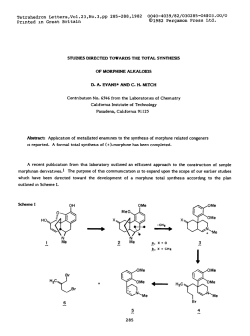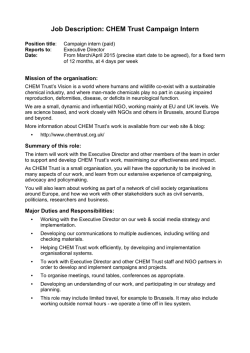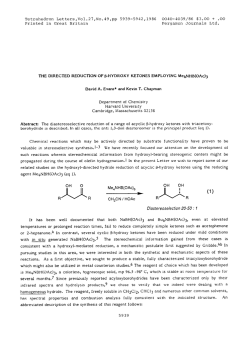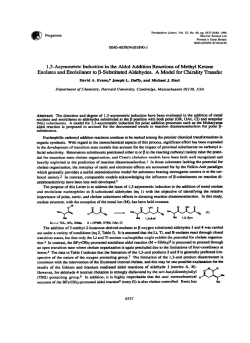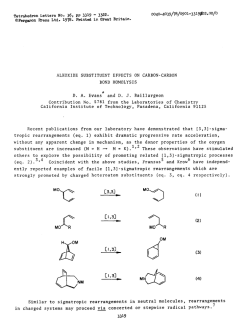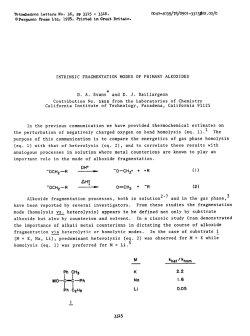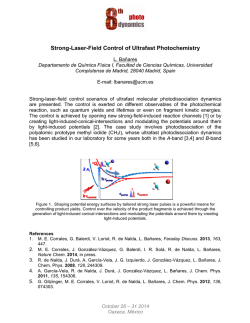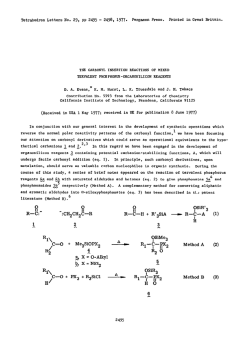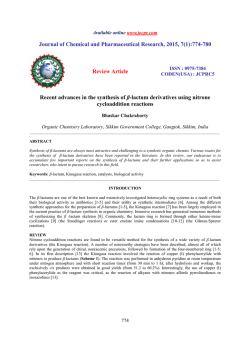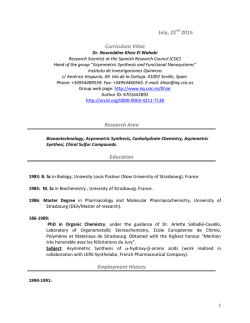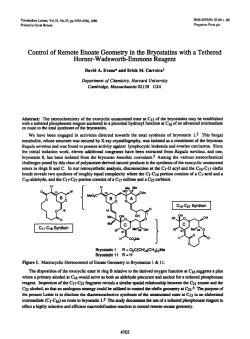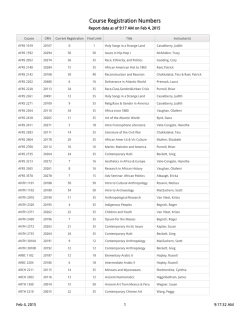
Tetrahedron Letters,Vo1.29,No.40,pp 5065-5068,1988 0040-4039
Tetrahedron Printed in Letters,Vo1.29,No.40,pp Great Britain 5065-5068,1988 0040-4039/88 $3.00 Percamon Press plc + .OO THE ASYMMETRIC SYNTHESIS OF P-LACTAM ANTIBIOTICS-V.* APPLICATION OF CHIRAL a&EPOXYIMINES IN RETENE-IMINE CYCLOADDITION REACTIONS LEADING TO HOMOCHIRAL 3-AMINOAZETIDINONES. David A. Evans* and J. Michael Williams Department of Chemistry, Harvard University Cambridge, Massachusetts 02138 USA Abstract: Imines derived from chiral a$-epoxyaldehydes have been shown to be useful chiral glyoxal imine synthons in the ketene-imine cycloaddition reaction. This process, which proceeds with high levels of reaction diastereoselection, affords enantiomerically pure &-substituted 3-amino-4alkylazetidinones in good yields. The economic incentive for the development of practical asymmetric syntheses of mono- and bicyclic plactam antibiotics continues to grow as those structures which exhibit exciting new broad-spectrum antibiotic activity evolve away from the more traditional penam and cephem nuclei. In short, bacterial mutation is continuing to elevate the demand for economically viable asymmetric synthesis methodology in this area. Recent efforts from this laboratory have addressed some of these issues, and high levels of asymmetric induction have been observed in those ketene-imine cycloaddition reactions employing chiral glycine synthons.2 The purpose of the present Letter is to disclose the diastereoselective cycloaddition of a$-epoxyimines and the one-step transformation of these azetidinone adducts to cis-substituted 3-amino-4-formylazetidinone derivatives as illustrated below (eq 1). This azetidinone intermediate has proven to be a versatile synthon for the synthesis of both monobactams and isocepham antibiotics3 and is viewed by us as one of the most generally useful chiral synthons for the production of new j3-lactam antibiotics. We were attracted to this approach to the synthesis of homochiral azetidinones as a consequence of the obvious utility of the Sharpless asymmetric epoxidation in providing direct access to those epoxyalcohols which are precursors to the requisite epoxyimines for the cycloaddition process.4 prior to the present study, Hubschwerlen and Schmid reported that imines derived from glyceraldehyde acetonide undergo highly diastereoselective cycloadditions with acid chlorides in the presence of triethylamine.5 Subsequent to this study, cycloadditions of related a-alkoxyimines have exhibited variable levels of internal asymmetric induction from the imine synthon. 6 On the other hand, in studies relevant to the reactions projected above, widely varying levels of carbonyl diastereoface selection have been documented in the addition reactions of organometallic reagents to a range of substituted a$-epoxyaldehydes. 7 Accordingly, the extrapolation of both the sense and degree of diastereoface selection from a-alkoxy- to a&epoxy aldehyde substrates, or their derived dialkylimonium analogs, appeared to be rather speculative for the reactions in question. This study provides documentation that these reactions are indeed highly diastereoselective in nature. 5065 5066 For the present study, rruns-cinnamyl alcohol and ~,@limethylallyl alcohol were chosen as informative epoxyimine precursors based on the following criteria. Both of these allylic alcohols are readily available, they exhibit high levels of asymmetric induction in the Sharpless epoxidationP and subsequent oxidative degradation of the derived cycloadducts with paraperiodic acid is based upon ample precedent. As advertised, the epoxidations of both truns-cinnamyl and B$-dimethylallyl alcohols proceeded in high yields with the (-)-diisopropyl tartrate catalyst, (-)-DIET, (7.5 mol %) in the presence of reti-butyl hydroperoxide and titanium isopropoxide to afford the epoxyalcohols la and 2a in >98% and 90% ee, respectively (eq 2-3).4 Based upon practical considerations, (2R,3R)-epoxycinnamyl alcohol (la) was found to be a mom attractive substrate from the standpoint of cost, enantiomeric purity, and ease of handling. Both la and 2a were oxidized using standard Swern conditions to give ca. 80% yields of the desired aldehydes lb and 2b. 8 These compounds are stable to silica gel chromatography and can be stored for at least several weeks at -20 ‘C under an inert atmosphere without decomposition. For obvious reasons, these aldehydes are not plagued with the traditional sensitivity towards racemization inherent with a-alkoxyaldehydes. HO Me 2b 2a The reactions of lb and 2b (or their enantiomers) with 1.0 equiv of the benzylamines listed in the Table (0.35 M in CH,C12,25 OC, 12 h) in the presence of activated 4A molecular sieves afforded the imines 3 and 4 which were used without further purification in the subsequent cycloaddition reactions (eq 4-5). 4 7 8 In a typical procedure, 1.Oequiv of the glycine acid chloride in anhydrous dichloromethane is cooled to 78 ‘C, and 1.5 equiv of aiethylamine is added, followed by a solution of the imine, the preparation of which is described above. The resulting mixture is allowed to warm to 0 ‘C over a 20-min period and is stirred for an additional 3-5 h before the reaction is quenched with dilute tartaric acid and the mixture subjected to a conventional extractive isolation. The yields cited for these reactions include both the Schiff base formation and cycloaddition steps; however, it is reasonable to expect that the oxidation, imine formation, and cycloaddition steps might be merged into a one-flask operation. In general, only cis azetidinones are observed in the unpurified reaction mixture, and the predominant product can be isolated in >98% diastereomeric purity by either chromatography or crystallization.9 The cases which were studied are listed in the Table. The only exception to the generality of the above reaction conditions is Entry 5. In this instance, only trace amounts of azetidinones were observed when Ncarbobenzoxyglycine acid chloride was subjected to the previously defined conditions. In this case, far better 5067 results were obtained when the acid chloride was prepared at temperatures not exceeding +lO “C and was added to a solution of the imine and triethylamine at -10 “C. Under these conditions, the major product 5d comprised >95% of the product isomers with the other three isomers accounting for ca. 4% of the azetidinone products. Table. Diaetereoselective Ketene-lmine Cycloeddition of Epoxyimines 3 and 4 (eq 4,5). Entry (R’) lmine 3,4 Glycyl Chloride (f+N) Ratio a 5:6 (7:8) 4, benzyl PhthN 97:3 (84) (74 i 17.511 a.2 3, benzyl PhthN 93:7 82 (56) cw 168-168.5 3,2,4-DMB ’ PhthN 93:7 85 (65) (5W 102.6-l 04.2 3,2,4-DMB ox d 91 :9 a4 (5c) oil 3,2,4-DMB CbzNH (60) (56) 164.4-l 3, CHpCOpt-Bu PhthN 91 :9 65 (51) (56) 168.6-l 69.5 3, C&(Me)C-CH2 PhthN 92:a 88 (51) 3, PMP * PhthN 90 :lO 66 (59) ’ Ratios daterminad either by Yield, %b >95:5 ‘H NMR spectroscopy or by HPLC. Product MP, “C 66 oil i i 8.4-i 19.8 b Yields are based on both the Schiff base and cycloadditfon steps. Yields of chromatographed product as a mixture of diadereomers. Values in parentheses refer to yields of 5 or 7 after either crystallization or cfvomatography. ’ 2.4sdimethoxybenzyl phenyloxazolin-2-c+3-yf. ‘para-methoxyphenyf. d4,5-di- Correlation of the absolute stereochemical course of each reaction necessitated degradation of the C-4 oxiranyl moieties derived from each imine to a common substituent. This enabled the absolute stereochemical relationships in epoxyimines 3 and 4 to be correlated with the absolute configurations of the major product diastereomers 5 and 7. This correlation was carried out in the following fashion for the cited cases. For those azetidinones in which the 3-amino substituent was phthalimidoprotected, cleavage of the oxirane with periodic acid (1.2 equiv in 1:l diethyl ether-dichloromethane, 25 “C, 12 h) provided 73-78% of the desired aldehydes 9 and 10 as illustrated below (eq 6).to Surprisingly, this degradation procedure did not proceed cleanly with the Cbz-protected azetidinone 5d. 7a, RI =Eh, b, R,=Me 5a, RI =Bn, R&i, Re=Ph 5b, R&4-DMB, Rp=H, Re=Ph 9, RI& 10, R, =2,4-DMB The absolute configurations of the azetidinones 9 and 10 were unambiguously determined by independent asymmetric synthesis through the ketene-imine cycloaddition methodology previously reported from this laborat0ry.h These experiments established the absolute stereochemistry of the azetidinones 7a, 5a, and Sb to IX as illustrated. The correlation of these adducts with the Cbz-protected azetidinone 5d was achieved by the manipulation of N-protecting groups. This was accomplished by removal of the phthalimido group in Sb with methylhydrazine (2.0 equiv in dichloromethane, 25 ‘C, 18 h) and reaction of the derived amine with Cbz-chloride (87% overall), providing 5d which was identical to the major product obtained directly by ketene-imine cycloaddition (Entry 5). The stereochemical assignments of the other adducts were assigned by analogy. Those stereochemical control elements which govern both the sense and degree of asymmetric induction in these reactions are difficult to assess in light of the continuing uncertainty associated with the mechanism of this 5068 process;t* nonetheless, it is interesting that the sense of asymmetric induction observed in this study correlates with the analogous reactions of the imines derived from (S)-glyceraldehyde acetonide.5 If the analogy to a carbonyl addition process is made for these reactions, it is reasonable that a component of the pi-facial bias of the imine moiety imposed by its a-oxygen substituent is stereoelectronic in nature. Accordingly, the preferred orientation of the C-O bond should be antiperiplanar to the forming C3-C4 azetidinone bond for transition state stabilization by delocalization into the C-O antibonding orbital, in analogy to related arguments for carbonyl addition.12 ln addition to these stereoelectronic effects, A( 1,3) allylic strain interactions might be expected to force the electrocyclization to be initiated from a nonplanar reactant cor&onnation. The illustrated clockwise conrotatory electrocyclization is consistent with the above stereoelectronic argument and other data on these types of processes.ll “,5 : % wzw H ” F5 H.“’ Clockwise > v-w) (7) y Conrotation % N+ --l-’ ‘R’ P+ \HFi’ -0 Acknowledgment. This research has been supported by Eli Lilly, the National Institutes of Health (GM33328-04) and the American Cancer Society. The NM BRS Shared Instrumentation Grant 1 SlO RRO1748OlAl is also acknowledged for providing NMR facilities. The authors would like to thank Dr. Thomas M. E&rich for helpful discussions relevant to the execution of some of the cycloadditions discussed in this paper. References and Notes For prior papers in this series see: Evans, D. A.; Sjogren, E. B. Tetrahedron L.ett. 1986,27,4961-4964 and previous citations. 2. (a) Evans, D. A.; Sjogren, E. B. Tetrahedron Lett. 1985,26,3783-3786. (b) Evans, D. A.; Sjogren, E. B. Tetrahedron L.ett. 1985.26. 3787-3790. 3. (a) Huffman. W. F.; Holden, K. G.; Buckley, T. F. IIk Gleason, J. G.; Wu, L. J. Am. Chem. Sot. 1977, 99, 2352-2353. (b) Bryan, D. B.; Hall, R. F.; Holden, K. G.; Huffman, W. F.; Gleason, J. G. J. Am. Chem. Sot. 1977,99, 2353-2355. (c) Hakimelahi, G. H.; Khalali-Nezhad, A. Helv. Chem. Acta 1984, 67, 18-20. (d) Mastalerz, H.; Vinet, V. J. Chem. Sot. Chem. Commun. 1987, 1283-1285. Gao, Y.; Hanson, R. M.; Klunder, I. M.; Ko, S. Y.; Masamune, H.; Sharpless, K. B. J. Am. Chem. Sot. 1987,109, 5765-5780. Hubschwerlen, C.; Schmid, G. Helv. Chim. Acta 1983,66, 2206-2209. For a convenient synthesis of (S)-glyceraldehyde acetonide see: Hubschwerlen, C. Synthesis, 1986,962-964. (a) Bremer, J. A. S.; Colvin, E. W.; Gallacher, G.; MacLeod, A. Tetrahedron L&t. 1983,24, 3783-3786. (b) Ito, Y.; Kawabata, T.; Terashima, S. Tetrahedron Lett. 1986,27, 5751-5754. (a) Molander, G. A.; Schubert, D. C. J. Am. Chem. Sot. 1987, 109, 576-578. (b) Takeda, Y.; Matsumoto, T.; Sato, F. J. Org. Chem. 1987,51, 4728-4731. (c) Howe, G. P.; Wang, S.; Procter, G. Tetrahedron Lett. 1987,28, 2629-2632. (a) Manusco, A. J.; Swern, D. Synthesis 1981, 165-185; For an example of the Swem oxidation applied to 8. epoxy alcohols see: (b) Molander, G. A.; Shubert, D. C. Reference 7a. While other oxidants have been recommended, in our hands these methods provided clean product but in substantially lower yields: (c) Rossiter, B. E.; Katsuki, T.; Sharpless, K. B. J. Am. Chem. Sot. 1981.103,464-465; (d) Reference 7c. 9. Satisfactory spectral data and elemental analyses were obtained on all new compounds prepared during the course of this study. Nagarkatti, J. P.; Ashley, K. R. Tetrahedron Z.&t. 1973, 4599-4600. ::: For a useful discussion of the mechanistic aspects of the ketene-imine cycloaddition see: (a) Moore, H. W.; Hughes, G.; Srinivasachar, K.; Femandez, M.; Nguyen, N. V. J. Org. Chem. 1985,50,4231-4238; (b) Holden, K. G. Chemistry and Biology of P-Lactam Antibiotics; Morin, R. B. and Gorman, M., Eds.; Academic Press: New York, 1982; Vol. 2, Chapter 2. (c) Koppel, G.A. Small Ring Heterocycles; Hassner, A., Ed.; Wiley: New York, 1983; Part 3, Chapter 2. 12. Anh, N. T.; Eisenstein, 0. Nouv. J. Chim. 1977,1, 61-70. 1. (Received in USA 11 July 1988)
© Copyright 2025
